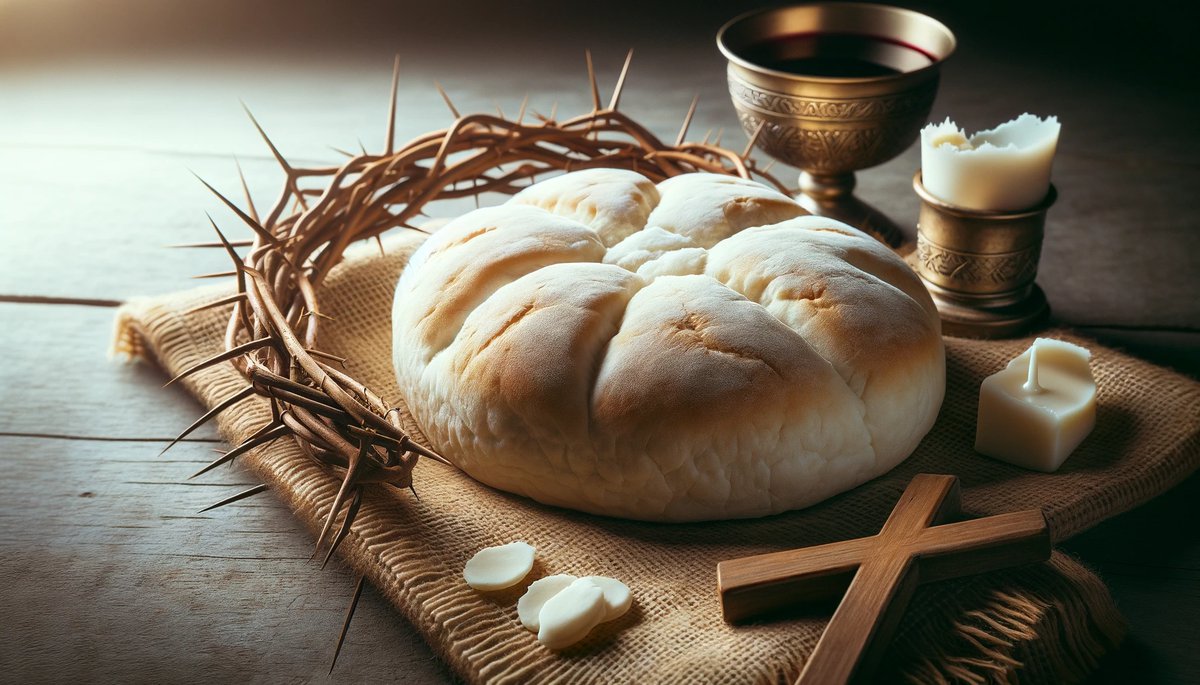Home>Theology and Spirituality>What To Do With Leftover Communion Bread


Theology and Spirituality
What To Do With Leftover Communion Bread
Published: February 19, 2024
Jason DeRose, Managing Editor at Christian.net, uses his expertise in religion and journalism to deepen understanding of faith's societal impacts. His editorial leadership, coupled with a strong academic background, enriches the platform’s diverse content, earning him recognition in both journalism and religious circles.
Discover creative and meaningful ways to use leftover communion bread in your theology and spirituality practice. Explore thoughtful ideas for repurposing communion bread with a spiritual focus.
(Many of the links in this article redirect to a specific reviewed product. Your purchase of these products through affiliate links helps to generate commission for Christian.net, at no extra cost. Learn more)
Table of Contents
Introduction
Leftover communion bread, also known as sacramental bread or altar bread, holds a significant place in religious ceremonies. It is a symbol of spiritual nourishment and unity within the Christian faith. However, there are times when a surplus of communion bread remains after the service. In such instances, it's essential to handle the leftovers with reverence and thoughtfulness.
The question arises: What should be done with the remaining communion bread? While it is crucial to handle it with respect, there are several practical and meaningful ways to utilize the surplus bread. This article will explore creative and respectful options for repurposing leftover communion bread, ensuring that it is treated with the reverence it deserves while minimizing waste.
As we delve into these suggestions, it's important to approach the topic with a sense of mindfulness and appreciation for the significance of the communion bread. Each option presented here aims to honor the spiritual essence of the bread while offering practical solutions for its use. Whether it involves transforming the bread into a new culinary creation or returning it to the natural world, the intention is to uphold the sacred nature of the communion bread while embracing sustainability and thoughtful stewardship.
With this in mind, let's explore various ways to handle leftover communion bread, recognizing the value it holds within the context of religious practice and the broader principles of mindful consumption and conservation.
Read more: What Bread Is Used For Communion
Option 1: Use it for making bread crumbs
After a religious service, it's not uncommon to have surplus communion bread. Rather than letting it go to waste, repurposing it into bread crumbs is a thoughtful and practical solution. This approach aligns with the principle of mindful consumption and stewardship, ensuring that the sacred essence of the communion bread is honored while minimizing unnecessary waste.
To begin the process of repurposing leftover communion bread into bread crumbs, it's essential to handle the bread with care and reverence. Start by allowing the bread to dry out completely, preserving its form and texture. Once the bread has dried, it can be transformed into fine or coarse bread crumbs, depending on the desired culinary applications.
The process of creating bread crumbs from leftover communion bread involves simple yet meaningful steps. Begin by breaking the dried bread into smaller pieces, then using a food processor or a manual method to grind it into the desired consistency. This process can be a meditative and intentional practice, acknowledging the spiritual significance of the bread while preparing it for a new purpose.
The resulting bread crumbs can be stored in airtight containers, ready to be used in various culinary endeavors. From coating and breading dishes to adding texture and flavor to casseroles and baked goods, homemade bread crumbs from surplus communion bread carry a sense of reverence and resourcefulness.
By repurposing leftover communion bread into bread crumbs, individuals and communities demonstrate a commitment to mindful stewardship and sustainability. This approach reflects a deep respect for the sacred nature of the communion bread while embracing the practicality of minimizing waste and repurposing resources.
In essence, using surplus communion bread for making bread crumbs is a meaningful way to extend the reverence for the bread beyond the religious service. It embodies the values of mindfulness, resourcefulness, and respect, ensuring that the sacred essence of the communion bread continues to enrich and nourish in various forms.
Ultimately, repurposing leftover communion bread into bread crumbs is a tangible expression of honoring the sacred while embracing the principles of sustainability and thoughtful stewardship. It is a simple yet profound way to ensure that the spiritual significance of the communion bread transcends its original purpose, resonating with mindfulness and respect for the blessings it embodies.
Option 2: Create a delicious bread pudding
Repurposing leftover communion bread into a delectable bread pudding offers a delightful and meaningful way to honor the sacred essence of the bread while minimizing waste. This approach aligns with the principles of mindfulness and resourcefulness, transforming surplus communion bread into a comforting and nourishing culinary creation.
To begin the process of creating a delicious bread pudding, the leftover communion bread should be handled with care and reverence. The bread, symbolic of spiritual nourishment, carries a profound significance that extends beyond its initial use in religious ceremonies. By repurposing it into a bread pudding, the essence of the bread is honored in a new and meaningful culinary context.
The transformation of surplus communion bread into a delectable bread pudding involves a thoughtful and intentional approach. The bread, often characterized by its simple and pure nature, becomes the cornerstone of a comforting and soulful dessert. As the bread is combined with ingredients such as milk, eggs, sugar, and warm spices, it undergoes a metamorphosis, embodying a sense of continuity and reverence.
The process of creating a bread pudding from leftover communion bread is a harmonious blend of culinary artistry and spiritual mindfulness. It involves soaking the bread in a rich custard mixture, allowing it to absorb the flavors and essence of the ingredients. This transformative process mirrors the sacred act of communion, where the bread becomes a vessel for spiritual nourishment and unity.
As the bread pudding bakes, the kitchen is filled with the aroma of warmth and comfort, echoing the sentiments of reverence and gratitude associated with the communion bread. The resulting dessert, with its golden crust and tender, custard-like interior, becomes a symbol of mindful stewardship and creative reverence for the sacred.
Serving a delicious bread pudding made from surplus communion bread is a meaningful way to extend the spiritual significance of the bread beyond the confines of the religious service. It embodies the values of mindfulness, creativity, and respect, ensuring that the sacred essence of the communion bread continues to nourish and uplift in a new and delightful form.
Ultimately, creating a delicious bread pudding from leftover communion bread is a tangible expression of honoring the sacred while embracing the principles of sustainability and thoughtful stewardship. It is a simple yet profound way to ensure that the spiritual significance of the communion bread transcends its original purpose, resonating with mindfulness and reverence for the blessings it embodies.
Option 3: Make a savory bread salad
Repurposing leftover communion bread into a savory bread salad offers a delightful and meaningful way to honor the sacred essence of the bread while minimizing waste. This approach aligns with the principles of mindfulness and resourcefulness, transforming surplus communion bread into a flavorful and nourishing culinary creation.
To begin the process of making a savory bread salad, the leftover communion bread should be handled with care and reverence. The bread, symbolic of spiritual nourishment, carries a profound significance that extends beyond its initial use in religious ceremonies. By repurposing it into a savory salad, the essence of the bread is honored in a new and meaningful culinary context.
The transformation of surplus communion bread into a savory bread salad involves a thoughtful and intentional approach. The bread, often characterized by its simple and pure nature, becomes the foundation of a vibrant and satisfying dish. As the bread is combined with an array of fresh ingredients such as ripe tomatoes, crisp cucumbers, fragrant herbs, and tangy vinaigrette, it undergoes a metamorphosis, embodying a sense of continuity and reverence.
The process of creating a savory bread salad from leftover communion bread is a harmonious blend of culinary artistry and spiritual mindfulness. It involves the careful integration of the bread with vibrant, seasonal produce and flavorful dressings, allowing the bread to absorb the essence of the ingredients. This transformative process mirrors the sacred act of communion, where the bread becomes a vessel for spiritual nourishment and unity, albeit in a culinary context.
As the savory bread salad comes together, the kitchen is filled with the aromas of freshness and vibrancy, echoing the sentiments of reverence and gratitude associated with the communion bread. The resulting dish, with its medley of textures and flavors, becomes a symbol of mindful stewardship and creative reverence for the sacred.
Serving a savory bread salad made from surplus communion bread is a meaningful way to extend the spiritual significance of the bread beyond the confines of the religious service. It embodies the values of mindfulness, creativity, and respect, ensuring that the sacred essence of the communion bread continues to nourish and uplift in a new and delightful form.
Ultimately, making a savory bread salad from leftover communion bread is a tangible expression of honoring the sacred while embracing the principles of sustainability and thoughtful stewardship. It is a simple yet profound way to ensure that the spiritual significance of the communion bread transcends its original purpose, resonating with mindfulness and reverence for the blessings it embodies.
Option 4: Share it with the birds and wildlife
Repurposing leftover communion bread by sharing it with the birds and wildlife offers a compassionate and ecologically mindful approach to honoring the sacred essence of the bread while minimizing waste. This option aligns with the principles of stewardship and interconnectedness, recognizing the spiritual significance of communion bread within the broader context of the natural world.
Sharing surplus communion bread with birds and wildlife begins with a deep sense of reverence and compassion. The bread, symbolizing spiritual nourishment and unity within the Christian faith, carries a profound significance that extends beyond human consumption. By offering it to the creatures of the natural world, the essence of the bread is honored in a new and meaningful ecological context.
The act of sharing communion bread with birds and wildlife embodies a spirit of interconnectedness and care for all living beings. It acknowledges the sacredness of the bread while extending its nourishing presence to the creatures that inhabit the same ecosystem. This act of generosity reflects a deep understanding of the interconnected web of life, where every being, no matter how small, is deserving of reverence and sustenance.
As the surplus communion bread is shared with birds and wildlife, it becomes a symbol of mindful stewardship and compassionate coexistence. The act of offering sustenance to the natural world echoes the sentiments of reverence and gratitude associated with the communion bread, extending its spiritual significance beyond human rituals and into the realm of ecological harmony.
By sharing surplus communion bread with birds and wildlife, individuals and communities demonstrate a commitment to mindful stewardship and ecological mindfulness. This approach reflects a deep respect for the sacred nature of the communion bread while embracing the interconnectedness of all life forms within the ecosystem.
Ultimately, sharing surplus communion bread with birds and wildlife is a tangible expression of honoring the sacred while embracing the principles of ecological stewardship and compassionate coexistence. It is a simple yet profound way to ensure that the spiritual significance of the communion bread transcends its original purpose, resonating with mindfulness and reverence for the interconnected web of life.
Read more: What Is Communion Bread Called
Conclusion
In conclusion, the handling of leftover communion bread is a practice that embodies both reverence for its sacred significance and a commitment to mindful stewardship. The options presented for repurposing surplus communion bread—whether through creating bread crumbs, crafting a delicious bread pudding, making a savory bread salad, or sharing it with birds and wildlife—reflect a harmonious blend of spiritual mindfulness and practical resourcefulness.
Each approach to repurposing leftover communion bread carries a profound significance, extending the reverence for the bread beyond its initial use in religious ceremonies. Whether it takes the form of culinary creativity, ecological mindfulness, or compassionate sharing, the handling of surplus communion bread underscores the interconnectedness of spiritual, ecological, and communal values.
By repurposing surplus communion bread into bread crumbs, bread pudding, or bread salad, individuals and communities honor the sacred essence of the bread while embracing the principles of sustainability and thoughtful stewardship. These culinary transformations not only minimize waste but also imbue the bread with new layers of meaning, extending its nourishing presence in ways that resonate with mindfulness and respect.
Furthermore, the act of sharing surplus communion bread with birds and wildlife reflects a deep understanding of the interconnected web of life, where every being, no matter how small, is deserving of reverence and sustenance. This compassionate gesture extends the spiritual significance of the bread into the realm of ecological harmony, embodying a spirit of interconnectedness and care for all living beings.
In essence, the handling of leftover communion bread transcends mere practicality; it becomes a meaningful expression of reverence, mindfulness, and stewardship. It bridges the sacred and the practical, the spiritual and the ecological, offering a holistic approach to honoring the significance of the communion bread within the context of religious practice and the broader principles of mindful consumption and conservation.
As individuals and communities engage in the thoughtful handling of surplus communion bread, they embody a commitment to honoring the sacred while embracing the interconnectedness of spiritual, ecological, and communal values. This holistic approach reflects a deep appreciation for the spiritual significance of the communion bread and its enduring presence in various forms, resonating with mindfulness and reverence for the blessings it embodies.














